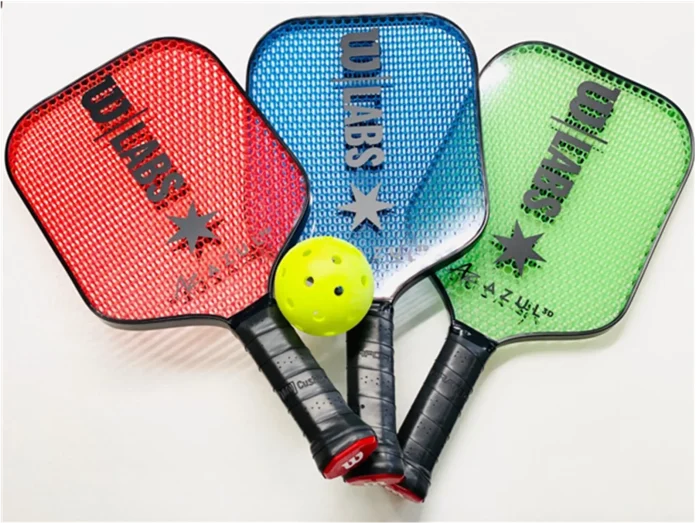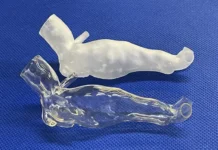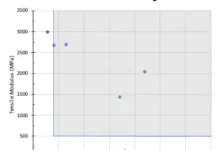By Liz Stevens, writer, UV+EB Technology
Azul 3D™, a Skokie, Illinois-based 3D printing company, and sports equipment manufacturer Wilson Sporting Goods, Chicago, Illinois, were able to connect for a pickleball paddle project after the Azul 3D team reached out to Wilson to demonstrate the size, throughput and industrial materials selection of its LAKE printer. Azul 3D, one of the key developers chosen by RadLaunch for its Start-up Technology Accelerator Class of 2020, was the only manufacturer that could combine the physical design, size and material properties needed to make the project a success.
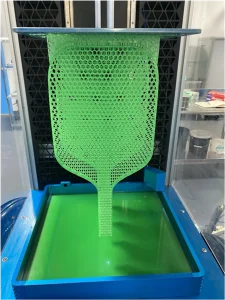
To push the bounds of manufacturing with 3D printing, the partnership with Wilson tapped Azul 3D’s proprietary High Area Rapid Printing (HARP™) technology and the five pillars of additive manufacturing: part consolidation, novel geometries, customization, digital inventory and localized manufacturing.
“Pickleball is one of the fastest-growing sports in America,” said Bob Thurman, vice president of Wilson Labs at Wilson Sporting Goods. “We were excited to work with Azul 3D to create a better paddle and better pickleball experience for our customers. We look forward to bringing this paddle to market.”
Pickleball paddle background
Pickleball, where players use wooden or composite paddles to hit a perforated plastic ball back and forth over a net on a badminton-sized court, is easy to learn and fun to play, and its popularity grew even more during the COVID-19 pandemic.
But players face two issues with paddles. First, the sound that the paddles make when they hit the ball can be loud – so loud, in fact, that neighbors near courts have complained to city councils and even filed lawsuits to shut down the courts. Second, since the sport is relatively new (invented in 1965) and can be fairly casual, the paddles – about twice the size of ping pong paddles – originally were homemade and never fully designed and optimized for the sport.
Wilson Sporting Goods and Azul 3D partnered to tackle both problems, eager to create better paddles for the ever-increasing number of players.
Consolidation of parts and creation of new geometries
The two companies began by exploring what Azul 3D’s HARP technology could create. The technology, a proprietary version of stereolithographic printing – a type of 3D printing that converts liquid plastic into solid objects using ultraviolet light – can print vertically at high speeds and over larger print areas than current commercial 3D printers.
HARP technology allowed the team to consider completely new geometries for the paddle. No longer was the geometry confined to the traditional manufacturing setup. The technology allowed the team to take five separate parts –two wooden handles, two fiberglass faces and a honeycomb core – and print them as one single piece.
An additional version of the paddle, with transparent faces, is manufactured in the traditional manner, with faces sourced from other parts of the supply chain and bonded to the Azul 3D-printed core. This transparent design was created to showcase the flexibility in the core geometries.
Novel geometries: designing the Quiet Paddle
Current paddle designs utilize uniform honeycomb combs that originate from the aerospace industry. When the fiberglass faces seal both sides, hundreds of tiny drums are created that emit a loud noise every time the paddle hits the ball.
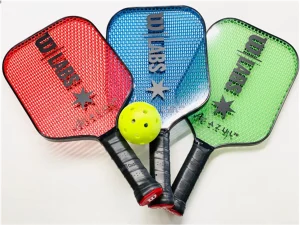
Using Azul 3D’s proprietary materials, the team designed a custom material that was able to withstand repeated hits and the outdoor environment; then it went to work creating a custom paddle design. The innovative design eliminates the traditional sealed chambers by patterning holes in the face of the paddle and including gaps in the columns that make up the core. This geometry – which is impossible to manufacture by traditional methods – reduces the total volume and changes the sound frequencies for the better, while still giving that ‘pop’ feel that players want.
This design ultimately became the Quiet Paddle. Considering the growth of the sport, and the extent of noise complaints, the Quiet Paddle could mitigate those concerns and help the sport grow even more popular.
Developing a completely customizable paddle
The team also developed a second paddle design with a completely customizable core. In traditional paddles, the honeycomb cores are hexagonal in shape, and players only have a couple of choices of core density, which is uniform throughout the paddle.
The LAKE printer supports custom geometries, and Wilson understood where players needed more or less feedback from the paddle. Azul 3D’s customizable cores can be created with lattices of different shapes – such as squares or triangles – or, potentially, different densities. This allows players to tune their paddles to the response that they want, such as reducing dead spots found in today’s paddles or doubling the density to increase the punch in certain areas, like the center or edge. Players even can pick the color and, eventually, the grip size. These options present a truly customized product.
Called the Custom Core paddle, this design conforms to pickleball paddle rules and could help players take their game to the next level. While the faces on the Quiet Paddle have holes to vent the honeycomb, the Custom Core paddles do not. Custom Core paddles are focused on customizing cores for playing styles rather than on reducing sound.
Digital inventory – printing on-demand
The paddles can be printed on demand with Azul 3D’s recently launched LAKE printer, which employs HARP technology to print products from a wide palette of materials over large areas. Post-printing tasks include a wash and post-cure.
Given the wide variety of customization possible, it is no longer necessary to predict demand ahead of time; products can be manufactured on demand to the customer’s specification.
With its continuous vertical printing, the LAKE printer can print multiple paddles with varying geometries in unison. It also can print them quickly. The LAKE printer can print 12 Custom Core paddles per batch, equivalent to 156 paddles in 24 hours or 57,000 in a single year.
Localized manufacturing: Eliminating supply chain issues
Because they can be printed on demand, the paddles reduce supply chain backups that have plagued many industries during the COVID-19 pandemic. While pickleball paddles often are assembled using five different pieces from different suppliers, these new paddles can be printed on-site, in one piece, using custom materials designed specifically for the product. This also reduces waste – nearly all the material is used toward creating the product. To finish, the paddle’s edge and handle are wrapped and decals are applied.
Both Azul 3D and Wilson Sporting Goods are based in the Chicago area, which allowed the collaboration, design and production to take place at Azul 3D’s headquarters, even during the COVID-19 pandemic. “We are a full-stack solution, partnering with manufacturers on everything from design, materials and printing to post-processing to ensure they have the best process on their factory floor,” said Azul 3D CEO Cody Petersen.



